Hypopharyngeal Cancer Treatment (PDQ®): Treatment - Patient Information [NCI]
This information is produced and provided by the National Cancer Institute (NCI). The information in this topic may have changed since it was written. For the most current information, contact the National Cancer Institute via the Internet web site at http://cancer.gov or call 1-800-4-CANCER.
General Information About Hypopharyngeal Cancer
Hypopharyngeal cancer is a disease in which malignant (cancer) cells form in the tissues of the hypopharynx.
The hypopharynx is the bottom part of the pharynx. The pharynx is a hollow tube about 5 inches long that starts behind the nose, goes down the neck, and ends at the top of the trachea (windpipe) and esophagus (the tube that goes from the throat to the stomach). Air and food pass through the pharynx on the way to the trachea or the esophagus. 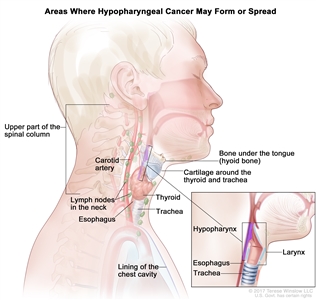
Hypopharyngeal cancer forms in the tissues of the hypopharynx (the bottom part of the throat). It may spread to nearby tissues or to cartilage around the thyroid or trachea, the bone under the tongue (hyoid bone), the thyroid, the trachea, the larynx, or the esophagus. It may also spread to the lymph nodes in the neck, the carotid artery, the tissues around the upper part of the spinal column, the lining of the chest cavity, and to other parts of the body (not shown).
Most hypopharyngeal cancers form in squamous cells, the thin, flat cells lining the inside of the hypopharynx. The hypopharynx has 3 different areas. Cancer may be found in 1 or more of these areas.
Hypopharyngeal cancer is a type of head and neck cancer.
Use of tobacco products and heavy drinking can affect the risk of developing hypopharyngeal cancer.
Anything that increases your risk of getting a disease is called a risk factor. Having a risk factor does not mean that you will get cancer; not having risk factors doesn't mean that you will not get cancer. Talk with your doctor if you think you may be at risk. Risk factors include:
- Smoking tobacco.
- Chewing tobacco.
- Heavy alcohol use.
- Eating a diet without enough nutrients.
- Having Plummer-Vinson syndrome.
Signs and symptoms of hypopharyngeal cancer include a sore throat and ear pain.
These and other signs and symptoms may be caused by hypopharyngeal cancer or by other conditions. Check with your doctor if you have:
- A sore throat that does not go away.
- Ear pain.
- A lump in the neck.
- Painful or difficult swallowing.
- A change in voice.
Tests that examine the throat and neck are used to help diagnose hypopharyngeal cancer and find out whether the cancer has spread.
The following tests and procedures may be used:
- Physical exam and health history: An exam of the body to check general signs of health, including checking for signs of disease, such as lumps or anything else that seems unusual. A history of the patient's health habits and past illnesses and treatments will also be taken.
- Physical exam of the throat: An exam in which the doctor feels for swollen lymph nodes in the neck and looks down the throat with a small, long-handled mirror to check for abnormal areas.
- Neurological exam: A series of questions and tests to check the brain, spinal cord, and nerve function. The exam checks a person's mental status, coordination, and ability to walk normally, and how well the muscles, senses, and reflexes work. This may also be called a neuro exam or a neurologic exam.
- CT scan (CAT scan): A procedure that makes a series of detailed pictures of areas inside the body, such as the head, neck, chest, and lymph nodes, taken from different angles. The pictures are made by a computer linked to an x-ray machine. A dye may be injected into a vein or swallowed to help the organs or tissues show up more clearly. This procedure is also called computed tomography, computerized tomography, or computerized axial tomography.
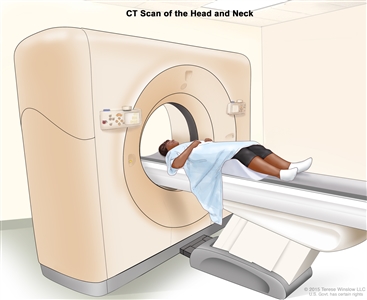
Computed tomography (CT) scan of the head and neck. The patient lies on a table that slides through the CT scanner, which takes x-ray pictures of the inside of the head and neck. - PET scan (positron emission tomography scan): A procedure to find malignant tumor cells in the body. A small amount of radioactive glucose (sugar) is injected into a vein. The PET scanner rotates around the body and makes a picture of where glucose is being used in the body. Malignant tumor cells show up brighter in the picture because they are more active and take up more glucose than normal cells do. A PET scan and CT scan may be done at the same time. This is called a PET-CT.
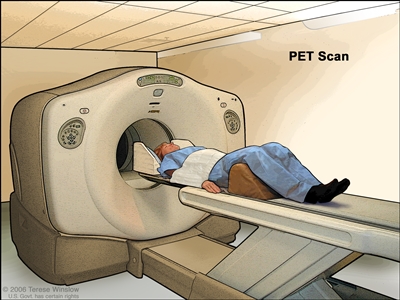
PET (positron emission tomography) scan. The patient lies on a table that slides through the PET machine. The head rest and white strap help the patient lie still. A small amount of radioactive glucose (sugar) is injected into the patient's vein, and a scanner makes a picture of where the glucose is being used in the body. Cancer cells show up brighter in the picture because they take up more glucose than normal cells do. - MRI (magnetic resonance imaging): A procedure that uses a magnet, radio waves, and a computer to make a series of detailed pictures of areas inside the body, such as the head, neck, chest, and lymph nodes. This procedure is also called nuclear magnetic resonance imaging (NMRI).
- Endoscopy: A procedure used to look at areas in the throat that cannot be seen with a mirror during the physical exam of the throat. An endoscope (a thin, lighted tube) is inserted through the nose or mouth to check the throat for anything that seems unusual. Tissue samples may be taken for biopsy.
- Biopsy: The removal of cells or tissues so they can be viewed under a microscope to check for signs of cancer.
- Bone scan: A procedure to check if there are rapidly dividing cells, such as cancer cells, in the bone. A very small amount of radioactive material is injected into a vein and travels through the bloodstream. The radioactive material collects in the bones with cancer and is detected by a scanner.
- Barium esophagogram: An x-ray of the esophagus. The patient drinks a liquid that contains barium (a silver-white metallic compound). The liquid coats the esophagus and x-rays are taken.
- Esophagoscopy: A procedure to look inside the esophagus to check for abnormal areas. An esophagoscope (a thin, lighted tube) is inserted through the mouth or nose and down the throat into the esophagus. Tissue samples may be taken for biopsy.
- Bronchoscopy: A procedure to look inside the trachea and large airways in the lung for abnormal areas. A bronchoscope (a thin, lighted tube) is inserted through the nose or mouth into the trachea and lungs. Tissue samples may be taken for biopsy.
Certain factors affect prognosis (chance of recovery) and treatment options.
Prognosis depends on:
- The stage of the cancer (whether it affects part of the hypopharynx, involves the whole hypopharynx, or has spread to other places in the body). Hypopharyngeal cancer is usually detected in later stages because early signs and symptoms rarely occur.
- The patient's age, sex, and general health.
- The location of the cancer.
- Whether the patient smokes during radiation therapy.
Treatment options depend on:
- The stage of the cancer.
- Keeping the patient's ability to talk, eat, and breathe as normal as possible.
- The patient's general health.
Patients who have had hypopharyngeal cancer are at an increased risk of developing a second cancer in the head or neck. Frequent and careful follow-up is important.
Stages of Hypopharyngeal Cancer
After hypopharyngeal cancer has been diagnosed, tests are done to find out if cancer cells have spread within the hypopharynx or to other parts of the body.
The process used to find out if cancer has spread within the hypopharynx or to other parts of the body is called staging. The information gathered from the staging process determines the stage of the disease. It is important to know the stage of the disease in order to plan treatment. The results of some of the tests and procedures used to diagnose hypopharyngeal cancer are often also used to stage the disease.
There are three ways that cancer spreads in the body.
Cancer can spread through tissue, the lymph system, and the blood:
- Tissue. The cancer spreads from where it began by growing into nearby areas.
- Lymph system. The cancer spreads from where it began by getting into the lymph system. The cancer travels through the lymph vessels to other parts of the body.
- Blood. The cancer spreads from where it began by getting into the blood. The cancer travels through the blood vessels to other parts of the body.
Cancer may spread from where it began to other parts of the body.
When cancer spreads to another part of the body, it is called metastasis. Cancer cells break away from where they began (the primary tumor) and travel through the lymph system or blood.
- Lymph system. The cancer gets into the lymph system, travels through the lymph vessels, and forms a tumor (metastatic tumor) in another part of the body.
- Blood. The cancer gets into the blood, travels through the blood vessels, and forms a tumor (metastatic tumor) in another part of the body.
The metastatic tumor is the same type of cancer as the primary tumor. For example, if hypopharyngeal cancer spreads to the lung, the cancer cells in the lung are actually hypopharyngeal cancer cells. The disease is metastatic hypopharyngeal cancer, not lung cancer.
The following stages are used for hypopharyngeal cancer:
The staging described below is only used for patients who have not had lymph nodes in the neck removed and checked for signs of cancer.
Stage 0 (carcinoma in situ)
In stage 0, abnormal cells are found in the lining of the hypopharynx. These abnormal cells may become cancer and spread into nearby normal tissue. Stage 0 is also called carcinoma in situ.
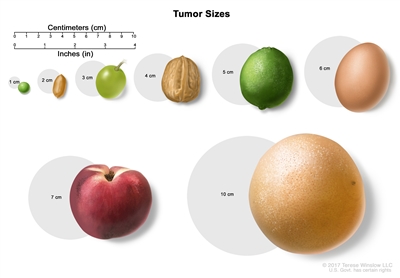
Tumor sizes are often measured in centimeters (cm) or inches. Common food items that can be used to show tumor size in cm include: a pea (1 cm), a peanut (2 cm), a grape (3 cm), a walnut (4 cm), a lime (5 cm or 2 inches), an egg (6 cm), a peach (7 cm), and a grapefruit (10 cm or 4 inches).
Stage I
In stage I, cancer has formed in only one area of the hypopharynx and/or the tumor is 2 centimeters or smaller.
Stage II
In stage II, the tumor is:
- found in more than one area of the hypopharynx or in a nearby area; or
- larger than 2 centimeters but not larger than 4 centimeters and has not spread to the larynx (voice box).
Stage III
In stage III, the tumor:
- is larger than 4 centimeters or has spread to the larynx (voice box) or the mucosa (inner lining) of the esophagus. Cancer may have spread to one lymph node on the same side of the neck as the tumor. The affected lymph node is 3 centimeters or smaller; or
- has spread to one lymph node on the same side of the neck as the tumor. The affected lymph node is 3 centimeters or smaller. Cancer is also found:
- in only one area of the hypopharynx and/or the tumor is 2 centimeters or smaller; or
- in more than one area of the hypopharynx or in a nearby area, or the tumor is larger than 2 centimeters but not larger than 4 centimeters and has not spread to the larynx.
Stage IV
Stage IV is divided into stages IVA, IVB, and IVC as follows:
- In stage IVA, the tumor:
- has spread to the thyroid cartilage, the bone above the thyroid cartilage, the thyroid gland, the cartilage around the trachea, the esophageal muscle, or the nearby muscles and fatty tissue in the neck. Cancer may have also spread to one lymph node on the same side of the neck as the tumor. The affected lymph node is 3 centimeters or smaller; or
- is found in the hypopharynx and may have spread to the thyroid cartilage, the bone above the thyroid cartilage, the thyroid gland, the cartilage around the trachea, the esophagus, or the nearby muscles and fatty tissue in the neck. Cancer has spread to one of the following:
- one lymph node on the same side of the neck as the tumor. The affected lymph node is larger than 3 centimeters but not larger than 6 centimeters; or
- more than one lymph node anywhere in the neck. The affected lymph nodes are 6 centimeters or smaller.
- In stage IVB, the tumor:
- may be any size and cancer may have spread to the thyroid cartilage, the bone above the thyroid cartilage, the thyroid gland, the cartilage around the trachea, the esophagus, or the nearby muscles and fatty tissue in the neck. Cancer has spread to a lymph node that is larger than 6 centimeters or has spread through the outside covering of a lymph node into nearby connective tissue; or
- has spread to the connective tissue covering the muscles that support the spinal column, the area around the carotid artery, or the area between the lungs. Cancer may have also spread to lymph nodes in the neck.
- In stage IVC, cancer has spread to other parts of the body, such as the lung, liver, or bone.
After surgery, the stage of the cancer may change and more treatment may be needed.
If the cancer is removed by surgery, a pathologist will examine a sample of the cancer tissue under a microscope. Sometimes, the pathologist's review results in a change to the stage of the cancer and more treatment is needed after surgery.
Hypopharyngeal cancer can recur (come back) after it has been treated.
The cancer may come back in the hypopharynx or in other parts of the body.
Treatment Option Overview
There are different types of treatment for patients with hypopharyngeal cancer.
Different types of treatment are available for patients with hypopharyngeal cancer. Some treatments are standard (the currently used treatment), and some are being tested in clinical trials. A treatment clinical trial is a research study meant to help improve current treatments or obtain information on new treatments for patients with cancer. When clinical trials show that a new treatment is better than the standard treatment, the new treatment may become the standard treatment. Patients may want to think about taking part in a clinical trial. Some clinical trials are open only to patients who have not started treatment.
The following types of treatment are used:
Surgery
Surgery (removing the cancer in an operation) is a common treatment for all stages of hypopharyngeal cancer. The following surgical procedures may be used:
- Laryngopharyngectomy: Surgery to remove the larynx (voice box) and part of the pharynx (throat).
- Partial laryngopharyngectomy: Surgery to remove part of the larynx and part of the pharynx. A partial laryngopharyngectomy prevents loss of the voice.
- Neck dissection: Surgery to remove lymph nodes and other tissues in the neck.
After the doctor removes all the cancer that can be seen at the time of the surgery, some patients may be given chemotherapy or radiation therapy after surgery to kill any cancer cells that are left. Treatment given after the surgery, to lower the risk that the cancer will come back, is called adjuvant therapy.
Radiation therapy
Radiation therapy is a cancer treatment that uses high-energy x-rays or other types of radiation to kill cancer cells or keep them from growing. External radiation therapy uses a machine outside the body to send radiation toward the area of the body with cancer.
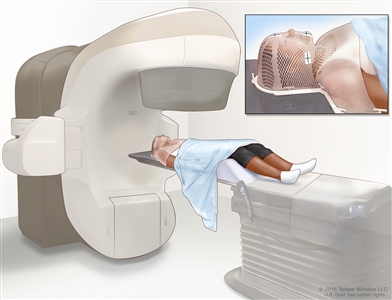
External-beam radiation therapy of the head and neck. A machine is used to aim high-energy radiation at the cancer. The machine can rotate around the patient, delivering radiation from many different angles to provide highly conformal treatment. A mesh mask helps keep the patient's head and neck from moving during treatment. Small ink marks are put on the mask. The ink marks are used to line up the radiation machine in the same position before each treatment.
Radiation therapy may work better in patients who have stopped smoking before beginning treatment. External radiation therapy to the thyroid or the pituitary gland may change the way the thyroid gland works. A blood test to check the thyroid hormone level in the body may be done before and after therapy to make sure the thyroid gland is working properly.
Chemotherapy
Chemotherapy is a cancer treatment that uses drugs to stop the growth of cancer cells, either by killing the cells or by stopping the cells from dividing. When chemotherapy is taken by mouth or injected into a vein or muscle, the drugs enter the bloodstream and can reach cancer cells throughout the body (systemic chemotherapy).
Chemotherapy may be used to shrink the tumor before surgery or radiation therapy. This is called neoadjuvant chemotherapy.
For more information, see Drugs Approved for Head and Neck Cancer. (Hypopharyngeal cancer is a type of head and neck cancer.)
Immunotherapy
Immunotherapy is a treatment that uses a person's immune system to fight cancer. Your doctor may suggest biomarker tests to help predict your response to certain immunotherapy drugs. Learn more about Biomarker Testing for Cancer Treatment.
Pembrolizumab and nivolumab are types of immunotherapy used to treat metastatic or recurrent hypopharyngeal cancer.
Learn more about Immunotherapy to Treat Cancer.
New types of treatment are being tested in clinical trials.
Information about clinical trials is available from the NCI website.
Treatment for hypopharyngeal cancer may cause side effects.
For information about side effects caused by treatment for cancer, visit our Side Effects page.
Patients may want to think about taking part in a clinical trial.
For some patients, taking part in a clinical trial may be the best treatment choice. Clinical trials are part of the cancer research process. Clinical trials are done to find out if new cancer treatments are safe and effective or better than the standard treatment.
Many of today's standard treatments for cancer are based on earlier clinical trials. Patients who take part in a clinical trial may receive the standard treatment or be among the first to receive a new treatment.
Patients who take part in clinical trials also help improve the way cancer will be treated in the future. Even when clinical trials do not lead to effective new treatments, they often answer important questions and help move research forward.
Patients can enter clinical trials before, during, or after starting their cancer treatment.
Some clinical trials only include patients who have not yet received treatment. Other trials test treatments for patients whose cancer has not gotten better. There are also clinical trials that test new ways to stop cancer from recurring (coming back) or reduce the side effects of cancer treatment.
Clinical trials are taking place in many parts of the country. Information about clinical trials supported by NCI can be found on NCI's clinical trials search webpage. Clinical trials supported by other organizations can be found on the ClinicalTrials.gov website.
Follow-up care may be needed.
As you go through treatment, you will have follow-up tests or check-ups. Some tests that were done to diagnose or stage the cancer may be repeated to see how well the treatment is working. Decisions about whether to continue, change, or stop treatment may be based on the results of these tests.
Some of the tests will continue to be done from time to time after treatment has ended. The results of these tests can show if your condition has changed or if the cancer has recurred (come back).
For hypopharyngeal cancer, follow-up to check for recurrence should include careful head and neck exams once a month in the first year after treatment ends, every 2 months in the second year, every 3 months in the third year, and every 6 months thereafter.
Treatment of Stage I Hypopharyngeal Cancer
For information about the treatments listed below, see the Treatment Option Overview section.
Treatment of stage I hypopharyngeal cancer may include:
- Laryngopharyngectomy and neck dissection with or without high-dose radiation therapy to the lymph nodes of the neck.
- Partial laryngopharyngectomy with or without high-dose radiation therapy to the lymph nodes on both sides of the neck.
Use our clinical trial search to find NCI-supported cancer clinical trials that are accepting patients. You can search for trials based on the type of cancer, the age of the patient, and where the trials are being done. General information about clinical trials is also available.
Treatment of Stage II Hypopharyngeal Cancer
For information about the treatments listed below, see the Treatment Option Overview section.
Treatment of stage II hypopharyngeal cancer may include:
- Laryngopharyngectomy and neck dissection. High-dose radiation therapy to the lymph nodes of the neck may be given before or after surgery.
- Partial laryngopharyngectomy. High-dose radiation therapy to the lymph nodes of the neck may be given before or after surgery.
- Chemotherapy given during or after radiation therapy or after surgery.
- A clinical trial of chemotherapy followed by radiation therapy or surgery.
Use our clinical trial search to find NCI-supported cancer clinical trials that are accepting patients. You can search for trials based on the type of cancer, the age of the patient, and where the trials are being done. General information about clinical trials is also available.
Treatment of Stage III Hypopharyngeal Cancer
For information about the treatments listed below, see the Treatment Option Overview section.
Treatment of stage III hypopharyngeal cancer may include:
- Radiation therapy before or after surgery.
- Chemotherapy given during or after radiation therapy or after surgery.
- A clinical trial of chemotherapy followed by surgery and/or radiation therapy.
- A clinical trial of surgery followed by chemotherapy given at the same time as radiation therapy.
- A clinical trial of chemotherapy given at the same time as radiation therapy.
Treatment and follow-up of stage III hypopharyngeal cancer is complex and is ideally overseen by a team of specialists with experience and expertise in treating this type of cancer. If all or part of the hypopharynx is removed, the patient may need plastic surgery and other special help with breathing, eating, and talking.
Use our clinical trial search to find NCI-supported cancer clinical trials that are accepting patients. You can search for trials based on the type of cancer, the age of the patient, and where the trials are being done. General information about clinical trials is also available.
Treatment of Stage IV Hypopharyngeal Cancer
For information about the treatments listed below, see the Treatment Option Overview section.
Treatment of stages IVA, IVB, and IVC hypopharyngeal cancer that can be treated with surgery may include:
- Radiation therapy before or after surgery.
- A clinical trial of chemotherapy followed by surgery and/or radiation therapy.
- A clinical trial of surgery followed by chemotherapy given at the same time as radiation therapy.
Surgical treatment and follow-up of stage IV hypopharyngeal cancer is complex and is ideally overseen by a team of specialists with experience and expertise in treating this type of cancer. If all or part of the hypopharynx is removed, the patient may need plastic surgery and other special help with breathing, eating, and talking.
Treatment of stages IVA, IVB, and IVC hypopharyngeal cancer that cannot be treated with surgery may include:
- Radiation therapy.
- Chemotherapy given at the same time as radiation therapy.
- A clinical trial of radiation therapy with chemotherapy.
Use our clinical trial search to find NCI-supported cancer clinical trials that are accepting patients. You can search for trials based on the type of cancer, the age of the patient, and where the trials are being done. General information about clinical trials is also available.
Treatment of Recurrent and Metastatic Hypopharyngeal Cancer
For information about the treatments listed below, see the Treatment Option Overview section.
Treatment of hypopharyngeal cancer that has recurred (come back) or that has spread to other parts of the body may include:
- Surgery.
- Radiation therapy.
- Chemotherapy.
- Immunotherapy (nivolumab or pembrolizumab).
- A clinical trial of chemotherapy.
Use our clinical trial search to find NCI-supported cancer clinical trials that are accepting patients. You can search for trials based on the type of cancer, the age of the patient, and where the trials are being done. General information about clinical trials is also available.
To Learn More About Hypopharyngeal Cancer
For more information from the National Cancer Institute about hypopharyngeal cancer, see:
- Head and Neck Cancer Home Page
- Oral Complications of Cancer Therapies
- Drugs Approved for Head and Neck Cancer
- Head and Neck Cancers
- Tobacco (includes help with quitting)
For general cancer information and other resources from the National Cancer Institute, visit:
About This PDQ Summary
About PDQ
Physician Data Query (PDQ) is the National Cancer Institute's (NCI's) comprehensive cancer information database. The PDQ database contains summaries of the latest published information on cancer prevention, detection, genetics, treatment, supportive care, and complementary and alternative medicine. Most summaries come in two versions. The health professional versions have detailed information written in technical language. The patient versions are written in easy-to-understand, nontechnical language. Both versions have cancer information that is accurate and up to date and most versions are also available in Spanish.
PDQ is a service of the NCI. The NCI is part of the National Institutes of Health (NIH). NIH is the federal government's center of biomedical research. The PDQ summaries are based on an independent review of the medical literature. They are not policy statements of the NCI or the NIH.
Purpose of This Summary
This PDQ cancer information summary has current information about the treatment of hypopharyngeal cancer. It is meant to inform and help patients, families, and caregivers. It does not give formal guidelines or recommendations for making decisions about health care.
Reviewers and Updates
Editorial Boards write the PDQ cancer information summaries and keep them up to date. These Boards are made up of experts in cancer treatment and other specialties related to cancer. The summaries are reviewed regularly and changes are made when there is new information. The date on each summary ("Updated") is the date of the most recent change.
The information in this patient summary was taken from the health professional version, which is reviewed regularly and updated as needed, by the PDQ Adult Treatment Editorial Board.
Clinical Trial Information
A clinical trial is a study to answer a scientific question, such as whether one treatment is better than another. Trials are based on past studies and what has been learned in the laboratory. Each trial answers certain scientific questions in order to find new and better ways to help cancer patients. During treatment clinical trials, information is collected about the effects of a new treatment and how well it works. If a clinical trial shows that a new treatment is better than one currently being used, the new treatment may become "standard." Patients may want to think about taking part in a clinical trial. Some clinical trials are open only to patients who have not started treatment.
Clinical trials can be found online at NCI's website. For more information, call the Cancer Information Service (CIS), NCI's contact center, at 1-800-4-CANCER (1-800-422-6237).
Permission to Use This Summary
PDQ is a registered trademark. The content of PDQ documents can be used freely as text. It cannot be identified as an NCI PDQ cancer information summary unless the whole summary is shown and it is updated regularly. However, a user would be allowed to write a sentence such as "NCI's PDQ cancer information summary about breast cancer prevention states the risks in the following way: [include excerpt from the summary]."
The best way to cite this PDQ summary is:
PDQ® Adult Treatment Editorial Board. PDQ Hypopharyngeal Cancer Treatment. Bethesda, MD: National Cancer Institute. Updated <MM/DD/YYYY>. Available at: https://www.cancer.gov/types/head-and-neck/patient/adult/hypopharyngeal-treatment-pdq. Accessed <MM/DD/YYYY>. [PMID: 26389254]
Images in this summary are used with permission of the author(s), artist, and/or publisher for use in the PDQ summaries only. If you want to use an image from a PDQ summary and you are not using the whole summary, you must get permission from the owner. It cannot be given by the National Cancer Institute. Information about using the images in this summary, along with many other images related to cancer can be found in Visuals Online. Visuals Online is a collection of more than 3,000 scientific images.
Disclaimer
The information in these summaries should not be used to make decisions about insurance reimbursement. More information on insurance coverage is available on Cancer.gov on the Managing Cancer Care page.
Contact Us
More information about contacting us or receiving help with the Cancer.gov website can be found on our Contact Us for Help page. Questions can also be submitted to Cancer.gov through the website's E-mail Us.
Last Revised: 2025-02-12
If you want to know more about cancer and how it is treated, or if you wish to know about clinical trials for your type of cancer, you can call the NCI's Cancer Information Service at 1-800-422-6237, toll free. A trained information specialist can talk with you and answer your questions.